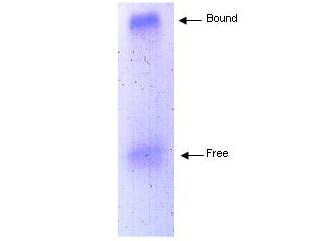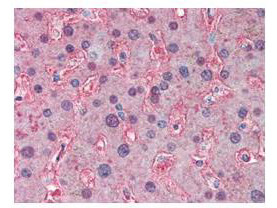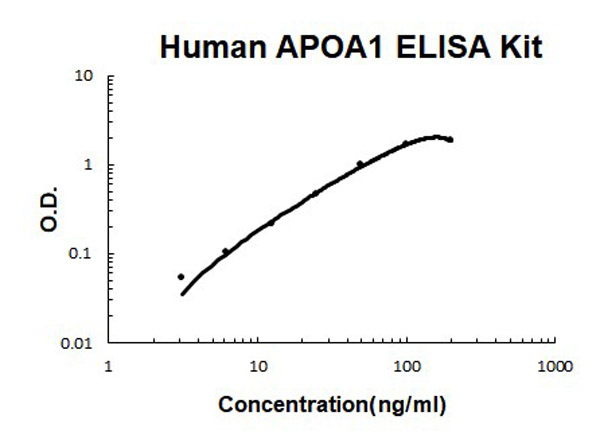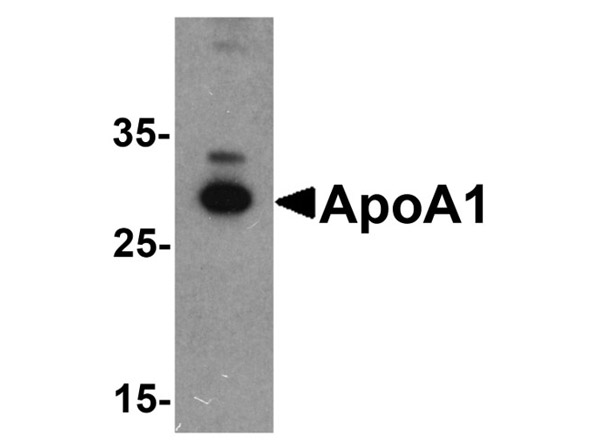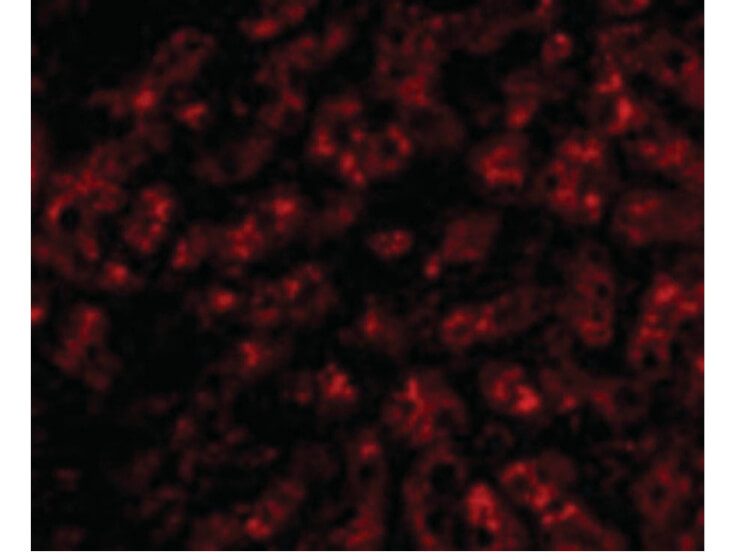APOLIPOPROTEIN A-I Antibody
Goat Polyclonal
11 References
600-101-109
1 mg
Liquid (sterile filtered)
WB, ELISA, IHC, IF
Human
Goat
Shipping info:
$50.00 to US & $70.00 to Canada for most products. Final costs are calculated at checkout.
Product Details
Anti-Apolipoprotein A-I (GOAT) Antibody - 600-101-109
goat anti-Apolipoprotein A-I Antibody, goat anti-APOA1 antibody, goat anti-APO-A1 antibody, goat anti-APOA-1 antibody, APOA1/APOC3 fusion gene antibody, Apolipoprotein A I precursor antibody, Apolipoprotein AI antibody, Apolipoprotein of high density lipoprotein antibody, ProapoA-I, Proapolipoprotein A-I, ApoA-I
Goat
Polyclonal
IgG
Target Details
APOA1 - View All APOA1 Products
Human
Native Protein
apoLipoprotein Type A-I was isolated from human plasma by density gradient centrifugation followed by HPLC purification, followed by repeated immunizations in goat.
Goat Anti-Apolipoprotein A-I Antibody has been prepared by immunoaffinity chromatography using immobilized antigens followed by extensive cross-adsorption against other apoLipoproteins and human serum proteins to remove any unwanted specificities. Typically less than 1% cross-reactivity against other types of apoLipoprotein was detected by ELISA against purified standards. This antibody reacts with human apoLipoprotein A-I and has negligible cross-reactivity with Type A-II, B, C-I, C-II, C-III, E and J apoLipoproteins. Specific cross-reaction of anti-apoLipoprotein antibodies with antigens from other species has not been determined. Non-specific cross-reaction of anti-apoLipoprotein antibodies with other human serum proteins is negligible.
Application Details
IHC, WB
ELISA, IF
- View References
Anti-apoLipoprotein antibodies have been tested by Western blot and IHC and are suitable for indirect trapping ELISA for quantitation of antigen in serum using a standard curve, for immunoprecipitation, immunohistochemistry and for western blotting for highly sensitive qualitative analysis.
Formulation
1.0 mg/mL by UV absorbance at 280 nm
0.125 M Sodium Borate, 0.075 M Sodium Chloride, 0.005 M EDTA, pH 8.0
0.01% (w/v) Sodium Azide
None
Shipping & Handling
Wet Ice
Store vial at 4° C prior to opening. This product is stable at 4° C as an undiluted liquid. Dilute only prior to immediate use. For extended storage mix with an equal volume of glycerol, aliquot contents and freeze at -20° C or below. Avoid cycles of freezing and thawing.
Expiration date is one (1) year from date of receipt.
Anti-Apolipoprotein A-I antibody recognizes the gene product of APOA1. Apolipoprotein promotes cholesterol efflux from tissues to the liver for excretion. Apolipoprotein A-I is the major protein component of high density lipoprotein (HDL) in the plasma. Synthesized in the liver and small intestine, it consists of two identical chains of 77 amino acids; an 18-amino acid signal peptide is removed co-translationally and a 6-amino acid propeptide is cleaved post-translationally. Variation in the latter step, in addition to modifications leading to so-called isoforms, is responsible for some of the polymorphism observed. APOA1 is a cofactor for lecithin cholesterolacyltransferase (LCAT) which is responsible for the formation of most plasma cholesteryl esters. The APOA1, APOC3 and APOA4 genes are closely linked in both rat and human genomes. The A-I and A-IV genes are transcribed from the same strand, while the C-III gene is transcribed convergently in relation to A-I. Defects in the apolipoprotein A-1 gene are associated with HDL deficiency and Tangier disease. Anti-Apolipoprotein A-I is useful for researchers interested in cardiovascular research.
Mathias RA et al. (2025). Apolipoprotein A1 (CSL112) Increases Lecithin-Cholesterol Acyltransferase Levels in HDL Particles and Promotes Reverse Cholesterol Transport. JACC Basic Transl Sci.
Applications
WB, IB, PCA
Didichenko SA et al. (2023). CSL112 Infusion Rapidly Increases APOA1 Exchange Rate via Specific Serum Amyloid-Poor HDL Subpopulations When Administered to Patients Post-Myocardial Infarction. Arterioscler Thromb Vasc Biol.
Applications
WB, IB, PCA
Jiang X et al. (2021). Intestinal and Hepatic Uptake of Dietary Peroxidized Lipids and Their Decomposition Products, and Their Subsequent Effects on Apolipoprotein A1 and Paraoxonase1. Antioxidants (Basel) .
Applications
EIA, ELISA; WB, IB, PCA
Navdaev AV. et al. (2020). Nascent HDL (High-Density Lipoprotein) Discs Carry Cholesterol to HDL Spheres. Effects of HDL Particle Remodeling on Cholesterol Efflux. Arteriosclerosis, Thrombosis, and Vascular Biology
Applications
WB, IB, PCA; IF, Confocal Microscopy
Gupta N et al. (2020). Domain-Specific Antibodies Reveal Differences in the Membrane Topologies of Apolipoprotein L1 in Serum and Podocytes. J Am Soc Nephrol.
Applications
WB, IB, PCA
Otis JP et al. (2019). Dietary cholesterol and apolipoprotein AI are trafficked in endosomes and lysosomes in the live zebrafish intestine. Am J Physiol Gastroinest Liver Physiol.
Applications
IF, Confocal Microscopy; WB, IB, PCA
Sato K et al. (2016). The majority of lipoprotein lipase in plasma is bound to remnant lipoproteins: A new definition of remnant lipoproteins. Clin Chim Acta.
Applications
WB, IB, PCA
Jani A et al. (2012). Kidney proteome changes provide evidence for a dynamic metabolism and regional redistribution of plasma proteins during torpor-arousal cycles of hibernation. Physiol Genomics.
Applications
WB, IB, PCA
Otis JP et al. (2011). Cholesterol and lipoprotein dynamics in a hibernating mammal. PLoS One
Applications
WB, IB, PCA
Wang XS et al. (2009). A sensitive and specific ELISA detects methionine sulfoxide-containing apolipoprotein AI in HDL. J Lipid Res.
Applications
E, EIA; SDS, 2D-PAGE
Martin SL et al. (2008). Proteomic analysis of the winter-protected phenotype of hibernating ground squirrel intestine. Am J Physiol Regul Integr Comp Physiol.
Applications
WB, IB, PCA
This product is for research use only and is not intended for therapeutic or diagnostic applications. Please contact a technical service representative for more information. All products of animal origin manufactured by Rockland Immunochemicals are derived from starting materials of North American origin. Collection was performed in United States Department of Agriculture (USDA) inspected facilities and all materials have been inspected and certified to be free of disease and suitable for exportation. All properties listed are typical characteristics and are not specifications. All suggestions and data are offered in good faith but without guarantee as conditions and methods of use of our products are beyond our control. All claims must be made within 30 days following the date of delivery. The prospective user must determine the suitability of our materials before adopting them on a commercial scale. Suggested uses of our products are not recommendations to use our products in violation of any patent or as a license under any patent of Rockland Immunochemicals, Inc. If you require a commercial license to use this material and do not have one, then return this material, unopened to: Rockland Inc., P.O. BOX 5199, Limerick, Pennsylvania, USA.

